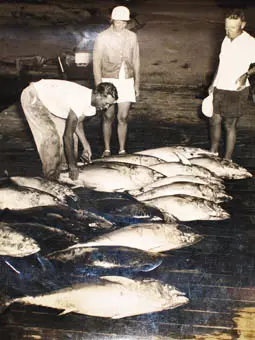Old-School Tuna Fishing

Polar bear-size bluefin once prowled near-shore Northeast waters and launched decades of epic tournament fishing.
In the early part of the 20th century, East Coast commercial fishermen were dismayed that bluefin tuna weighing 500-plus pounds were wreaking havoc on their bluefish and herring nets. These brutish fish were often within casting distance of the rocky jetties off New Jersey’s Shrewsbury Rocks and within sight of the Manhattan skyline.
Around the same time, charter fishing boats trolling for bluefish around New Jersey’s many craggy inlets were also encountering these fish, which were known as “horse mackerel.” It didn’t take long before anglers focused on catching monster fish as near-shore giant tuna in the 300- to 400-pound class were in large supply during the 1920s and 1930s. Those pursuing the behemoths battled using “leather thumb stalls,” which means they used their finger and a leather pad to supplement a reel’s internal drag system. The drags and line often had to be replaced after one fish (the fingers usually stayed, though). Area anglers soon became proficient at catching these massive pelagics.
In the 1930s, two fishing clubs located roughly 35 miles apart threw down the gauntlet for giant bluefin tuna bragging rights in a two-boat-only event that featured a team from Freeport, New York, and one from Manasquan, New Jersey. Without giant dock parties and fanfare, captain’s meetings, or beer sponsors, the two teams fished head-to-head and exchanged their catch weights via a landline telephone. Tournament tuna fishing had begun.
Getting an invite to compete in the USATT and a chance to catch giants was a highly sought after prize for anglers.
Clubs feverishly began to form, with some incorporating marlin and tuna into their name. There were New Jersey clubs from Atlantic City, Forked River, and Beach Haven, and New York ones based in Manhassett Bay, Sheepshead Bay, Babylon, Shinnecock, and Montauk. The Manasquan River Marlin & Tuna Club (MRMTC) was one of the earliest. (This group’s exploits have been wonderfully chronicled in a limited-edition hardcover book called The History of the Manasquan River Marlin & Tuna Club, www.mrmtc.com.)
Here’s a brace of tuna being weighed in at a doubles tournament.“We caught a 400-pound-class bluefin and tied for the division win. We used real wire leaders in those days, and I was pretty inexperienced. I held on for dear life, getting pretty cut up in the process. It was quite an honor to be included in the crew,” reflects Ristori.Long Island captain Jesse York adds, “In comparison to today’s tournaments, the USATT was much different. It wasn’t commercial; we fished for trophies and bragging rights. No prize money was involved, it was all about honor.”York and his crew fished aboard the Compass Rose, which featured an expansive cockpit made for holding big fish. He’s still very proud of winning the USATT President’s Tournament, a spin-off event reserved for the president of each competing fishing club. His crew once trolled up a 730-pounder when the event was held out of Provincetown, Massachusetts.“Those tournaments were run like the army. Identical amounts of bait were distributed to each boat, no exceptions. It was a level playing field. We received our awards at the New York Athletic Club,” says York.The tournament kept following the fish north, and eventually, in Feuring’s opinion, the distance became too great for most boats to participate. Many crews and boats came from the New York metropolitan area and were the driving force for the competition so interest faded. And with that, sadly, the USATT had faded into angling history by the mid-1990s.
Though the tournament has disappeared, have the bluefin tuna that made it possible followed suit?Marine biologists started collecting population and migratory data in earnest around 1980. Dr. Molly Lutcavage, director of the Large Pelagics Research Center (University of Massachusetts-Amherst), started her tuna research in 1993.“We’ve seen a lot of changes in the fishery. The use of spotter pilots [has] broadened our window,” says Lutcavage, adding that the numbers of bluefin tuna in the Gulf of Maine may actually be higher than previously thought.She believes the entire system has shifted. The complexity of the occurrence involves oceanographic conditions, prey, and increased seawater temperatures that effect plankton bloom, hatching of bait, and spawning.In her opinion, there is a healthy biomass of bluefin around the George’s Bank and Gulf of Maine area, and there are large schools of juveniles from New Jersey up to Nova Scotia. The juveniles sampled consistently show that a large percentage of these young fish have Mediterranean origins.
Bluefin were once considered great game fish but not table fare.“What that suggests is a subsidy of fish spawned in the Med [and] made their way to our continental shelf. However, only a small portion of the giant [tuna here] reflect [having] any signs from the Mediterranean stock. Adult fish sampled to date appear to have Western origins,” says Lutcavage. And the Western stock has been well-documented as a decimated group of fish (see “Conservation Corner,” this issue).The Northeast giants seemingly travel to here and Canada to eat and then head to the Gulf of Mexico to spawn. Data suggests that these fish all stay in the western Atlantic. Scientists have found from their satellite pop-up tag research that giants shift patterns yearly, and a Nova Scotian fish can have up to four separate migration routes.There is some speculation that there may be different spawning areas, too. One might be on the eastern side of the Gulf Stream, and marine biologists question if some fish annually spawn there or simply go other places. Lutcavage believes the biomass is still somewhat a mystery, but scientists hope that catch data, sonar, and aerial surveys will offer a clearer picture what is out there.So could we ever see a return to the fish-filled tournament days of old? Feuring doesn’t think so. “The tuna follow the herring and stay with the food. Herring and mackerel stayed in close to the New York Bight in the early years. The cycle changed for whatever reasons, due to pollution or water temps, and those events have moved on,” he says, adding, “They’re gone.” For the fortunate few who got to witness this big-game spectacle just outside the lights of Manhattan and off the shores of New England, it was a helluva party while it lasted. And here’s hoping that someday history may repeat itself.This article originally appeared in the April 2011 issue of Power & Motoryacht magazine.Photos Courtesy of Manasquan River Marlin & Tuna Club

